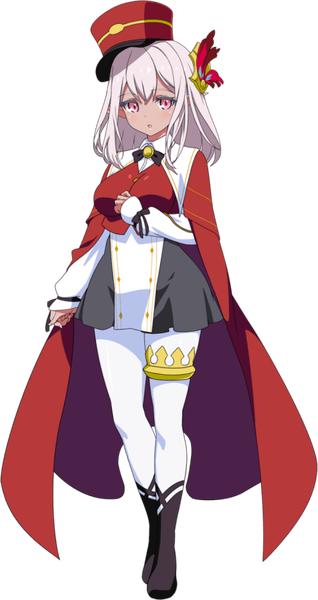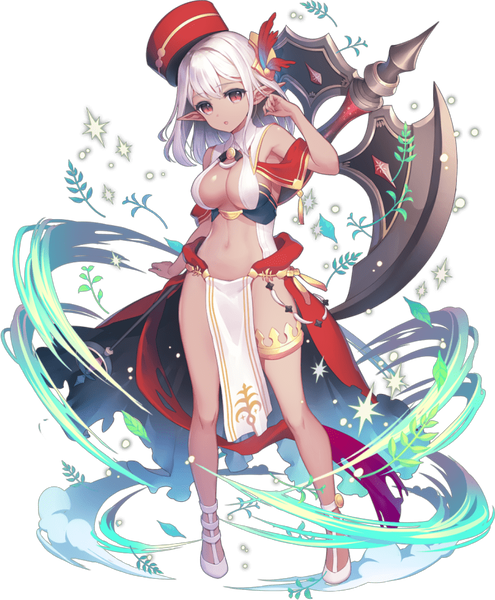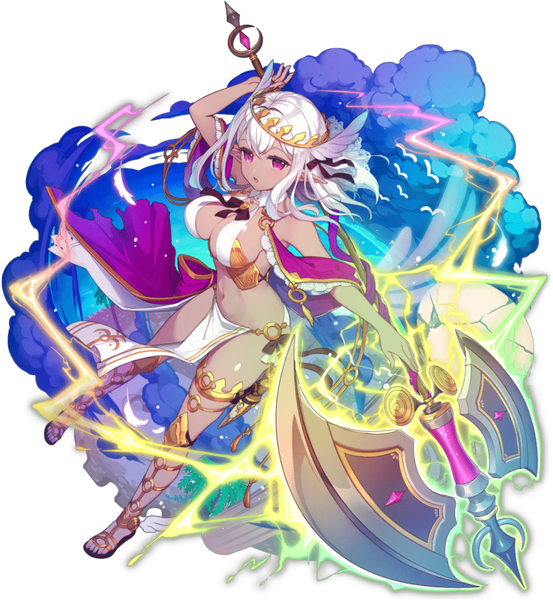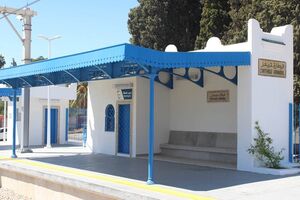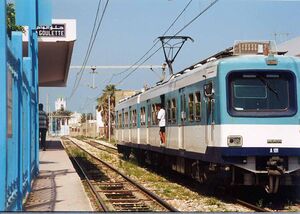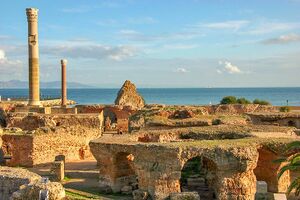Carthage
| Carthage | |||||
|---|---|---|---|---|---|
| Japanese Name | カルタゴ | ||||
| Weapon | |||||
| Race | Dark Elf | ||||
| Nationality | |||||
| Birthday | June 21 | ||||
| Constellation | Gemini | ||||
| Talents | Mountain climbing | ||||
| Likes | A strong body, Giant things | ||||
| Dislikes | Dislikes (but not necessarily hate) small animals | ||||
| Strengths | Great reflexes, Extremely intellectually curious | ||||
| Weaknesses | Tends to confuse people due to the difference in culture | ||||
| Hobbies | Weight training, Studying | ||||
I'm a descendant of an ancient tribe of Verforet barbarians that terrorizes these forests. But my ancestors didn't really have much to say or leave behind, so I don't really know why they did what they did. So I'm relying on you, Teacher, and all the stuff I can find at the library. I'm right in the middle of filling the gaps in our history.
Layers
| Icon | Title | Release Date | Where to Obtain |
|---|---|---|---|
| [Student From Dark Continent] Carthage | 2022 February 1 (EN) | [Valentine's Day is Canceled] Event Reward | |
| [Well-Toned Body Language] Carthage | 2022 May 1 (EN) | [An Angel in the Isolation Ward] Limited Gacha | |
| [Filling Historical Gaps] Carthage | 2022 April 30 | [Lost Ship at the Wilderness End] Pick Up Gacha, Premium Gacha |
Skills
Trivia
- Carthage's birthday is the date of the establishment of the Tunisian government in 1956.
- The contrasting relationship and theme between Anzio and Carthage mirrors the contrast between the 'civilized' ancient Roman Empire and the 'barbaric, godless' Carthaginian empire.
- The ocean view with ruins in the background of Filling Historical Gaps refers to the Punic Ports of Carthage, which established Carthage as a naval and trading power.
- The circular golden ornaments on Carthage's axe resemble the circle patterns on the Ksour Essef cuirass, an artifact of Italian construction found in a Carthaginian tomb. This connection is similar to that of Carthage's to Verforet.
- Carthage's research on the history of the dark elf barbarians who pillaged ancient Verforet is a reference to the Second Punic War, a conflict fought in 218 BC - 201 BC between Rome and Carthage. Called as a 'barbarian', Hannibal scared the Romans by invading them over the mountains from Hispania with war elephants with his Carthaginian forces.
- Carthage's lack of a verbal language likely derives from how very little Carthaginian writing, known as the Punic language, survives to this day. One of the major sources on Punic is the comedy play Poenulus, which featured a Carthaginian trader speaking in genuine Punic but who is constantly misunderstood and mistranslated.
- Carthage's Special Skill, Al'Aqwaadar is Algerian Arabic for الأقوىدار (The Strongest).
Counterpart
Tunis-Goulette-Marsa (TGM) was the first railway in Tunisia. It was inaugurated in 1872, and has been known as the TGM since 1905. It is part of the transportation system of the Tunis area, and is managed by the Société des transports de Tunis (Transtu), which also manages the light rail of Tunis (Le métro léger de Tunis). Transtu was founded in 2003 by joining the Société du métro léger de Tunis (SMLT, founded 1981) and the Société nationale de transports (SNT, founded 1963).
Tunisia inherited much of its rail transport system from the French and the Tunisian Government has developed the infrastructure further. Due to historical reasons, the country has two different track gauge systems. Thus SNCFT manages 471 km of 1435 mm (4 ft 8+1⁄2 in) standard gauge network in the northern and a 1674 km of 1000 mm (3 ft 3+3⁄8 in) metre gauge network in the central and southern part of the country (65 km electrified); only 8 km are dual gauge track (2006). Tunisia has a rail link with neighbouring Algeria via the border at Ghardimaou, but passenger services are limited to a single round-trip per day (as at summer 2008).
In 1870, the Italian company Mancardi was granted a concession for a railway between Tunis and the Sahel region but due to lack of capital was unable to build it. Instead, the first railway line in Tunisia linked Tunis with La Marsa - today's TGM line - and was inaugurated on August 2, 1872 by Sadok Bey. In 1872 the British Pickering company was allowed to build a standard gauge railway between Tunis and Jendouba with a concession for 50 years. However, as the plan was not implemented, in 1876, the French Corporation des Batignolles and its subsidiary, the Compagnie des chemins de fer Bône-Guelma, took over. Work started on April 30, 1877. The link with Algeria was completed by September 29, 1884. In 1894, the route was linked to Bizerte. Later links were extended to Béja Mateur (1912) and Tabarka (1922). The French company was granted operational rights until 1922, after which it would be sold to the Tunisian state.
The suburb has six train stations of the TGM line between Le Kram and Sidi Bou Said: Carthage Salammbo (named for Salambo, the fictional daughter of Hamilcar), Carthage Byrsa (named for Byrsa hill), Carthage Dermech (Dermèche), Carthage Hannibal (named for Hannibal), Carthage Présidence (named for the Presidential Palace) and Carthage Amilcar (named for Hamilcar). TGM is one of the oldest electric railways in Africa. Wikipedia
Carthage was founded in the 9th century B.C. on the Gulf of Tunis. From the 6th century onwards, it developed into a great trading empire covering much of the Mediterranean and was home to a brilliant civilization. In the course of the long Punic wars, Carthage occupied territories belonging to Rome, which finally destroyed its rival in 146 B.C. A second – Roman – Carthage was then established on the ruins of the first.
Founded by the Phoenicians, Carthage is an extensive archaeological site, located on a hill dominating the Gulf of Tunis and the surrounding plain. Metropolis of Punic civilization in Africa and capital of the province of Africa in Roman times, Carthage has played a central role in Antiquity as a great commercial empire. During the lengthy Punic wars, Carthage occupied the territories that belonged to Rome, which then destroyed its rival in 146 AD. The town was rebuilt by the Romans on the ruins of the ancient city.
The open-air Carthage Paleo-Christian Museum has exhibits excavated under the auspices of UNESCO from 1975 to 1984. The site of the ruins is a UNESCO World Heritage Site. UNESCO
Map
Gallery
- Pages using Tabber parser tag
- Pages using DynamicPageList3 parser tag
- Weapon Axe
- Dark Elf
- Verforet
- Gemini
- Element Cut
- Element Fire
- Train Knights
- Tunisia

